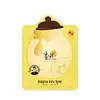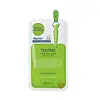What's inside
What's inside
 Key Ingredients
Key Ingredients

 Benefits
Benefits

 Concerns
Concerns

 Ingredients Side-by-side
Ingredients Side-by-side

Water
Skin ConditioningGlycerin
HumectantButylene Glycol
HumectantMethyl Hydroxyethylcellulose
StabilisingGlyceryl Acrylate/Acrylic Acid Copolymer
HumectantPropylene Glycol
HumectantPvm/Ma Copolymer
Emulsion StabilisingTrehalose
HumectantPEG-60 Hydrogenated Castor Oil
EmulsifyingPanthenol
Skin ConditioningCarbomer
Emulsion StabilisingArginine
MaskingDisodium EDTA
Allantoin
Skin ConditioningDipotassium Glycyrrhizate
HumectantSodium Hyaluronate
HumectantGlycyrrhiza Glabra Root Extract
Bleaching1,2-Hexanediol
Skin ConditioningCaprylyl Glycol
EmollientSchisandra Chinensis Fruit Extract
Skin ConditioningCoptis Japonica Extract
AntimicrobialZingiber Officinale Root Extract
MaskingCamellia Sinensis Leaf Extract
AntimicrobialCitrus Grandis Seed Extract
AstringentAcorus Gramineus Root/Stem Extract
Skin ConditioningPerilla Ocymoides Leaf Extract
TonicHoney Extract
HumectantPropolis Extract
Skin ConditioningParfum
MaskingWater, Glycerin, Butylene Glycol, Methyl Hydroxyethylcellulose, Glyceryl Acrylate/Acrylic Acid Copolymer, Propylene Glycol, Pvm/Ma Copolymer, Trehalose, PEG-60 Hydrogenated Castor Oil, Panthenol, Carbomer, Arginine, Disodium EDTA, Allantoin, Dipotassium Glycyrrhizate, Sodium Hyaluronate, Glycyrrhiza Glabra Root Extract, 1,2-Hexanediol, Caprylyl Glycol, Schisandra Chinensis Fruit Extract, Coptis Japonica Extract, Zingiber Officinale Root Extract, Camellia Sinensis Leaf Extract, Citrus Grandis Seed Extract, Acorus Gramineus Root/Stem Extract, Perilla Ocymoides Leaf Extract, Honey Extract, Propolis Extract, Parfum
Water
Skin ConditioningGlycerin
HumectantPropanediol
Solvent1,2-Hexanediol
Skin ConditioningSalix Alba Bark Extract
AstringentButylene Glycol
HumectantXanthan Gum
EmulsifyingBetaine
HumectantTrehalose
HumectantPanthenol
Skin ConditioningPolysorbate 80
EmulsifyingAllantoin
Skin ConditioningArginine
MaskingCarbomer
Emulsion StabilisingDisodium EDTA
Boswellia Serrata Resin Extract
SmoothingMelaleuca Alternifolia Leaf Extract
PerfumingDipotassium Glycyrrhizate
HumectantTocopheryl Acetate
AntioxidantEthylhexylglycerin
Skin ConditioningGlycine Max Seed Extract
Skin ConditioningLavandula Angustifolia Extract
Skin ConditioningCymbopogon Schoenanthus Extract
Skin ConditioningRosmarinus Officinalis Leaf Extract
AntimicrobialCentella Asiatica Extract
CleansingSalvia Officinalis Extract
AntimicrobialHouttuynia Cordata Extract
Skin ConditioningPisum Sativum Extract
Skin ConditioningChamomilla Recutita Extract
Skin ConditioningMelaleuca Alternifolia Leaf Oil
AntioxidantWater, Glycerin, Propanediol, 1,2-Hexanediol, Salix Alba Bark Extract, Butylene Glycol, Xanthan Gum, Betaine, Trehalose, Panthenol, Polysorbate 80, Allantoin, Arginine, Carbomer, Disodium EDTA, Boswellia Serrata Resin Extract, Melaleuca Alternifolia Leaf Extract, Dipotassium Glycyrrhizate, Tocopheryl Acetate, Ethylhexylglycerin, Glycine Max Seed Extract, Lavandula Angustifolia Extract, Cymbopogon Schoenanthus Extract, Rosmarinus Officinalis Leaf Extract, Centella Asiatica Extract, Salvia Officinalis Extract, Houttuynia Cordata Extract, Pisum Sativum Extract, Chamomilla Recutita Extract, Melaleuca Alternifolia Leaf Oil
 Reviews
Reviews

Ingredients Explained
These ingredients are found in both products.
Ingredients higher up in an ingredient list are typically present in a larger amount.
1,2-Hexanediol is a synthetic liquid and another multi-functional powerhouse.
It is a:
- Humectant, drawing moisture into the skin
- Emollient, helping to soften skin
- Solvent, dispersing and stabilizing formulas
- Preservative booster, enhancing the antimicrobial activity of other preservatives
Allantoin is a soothing ingredient known for its protective and moisturizingg properties. Because of this, it is often added to products with strong active ingredients.
Studies show higher concentrations of this ingredient can promote wound healing.
Though it can be derived from the comfrey plant, allantoin is produced synthetically for cosmetic products to ensure purity.
Learn more about AllantoinArginine is an amino acid that is important for human development. Your body uses is it to produce hair keratin and skin collagen.
As a cosmetic ingredient, Arginine has antioxidant properties and can also help repair damaged skin. This ingredient is derived either synthetically or from animals.
Arginine isn't fungal acne safe when used in the presence of other lipids (fats, fatty acids, oils, esters, etc). Oils and fats occur naturally within the skin, so take caution when using Arginine if you're prone to fungal acne.
Learn more about ArginineButylene Glycol (or BG) is used within cosmetic products for a few different reasons:
Overall, Butylene Glycol is a safe and well-rounded ingredient that works well with other ingredients.
Though this ingredient works well with most skin types, some people with sensitive skin may experience a reaction such as allergic rashes, closed comedones, or itchiness.
Learn more about Butylene GlycolCarbomer is a polymer of acrylic acid. Its main role is to create a gel consistency.
A high amount of carbomer can cause pilling or balling up of products. Don't worry, most products contain 1% or less of carbomer.
Dipotassium Glycyrrhizate comes from licorice root.
Extracts of licorice have demonstrated to have antibacterial, anti‐inflammatory, antiviral, antioxidant properties.
One component, glabridin, has extra potent antioxidant and soothing properties. It has also been found to block pigmentation from UVB rays in guinea pigs.
Licorice Root also contains a flavonoid. Flavonoids are a natural substance from in plants. Flavonoids also have antioxidant properties.
Another component, glycyrrhizin, has been found to have anti-inflammatory and antimicrobial benefits. This may make licorice root extract effective at treating acne. However, more research is needed to support this.
Liquiritin is one of the flavone compounds found in licorice. It has been found to help lighten skin by preventing tyrosinase from reacting with tyrosine. When the two react, protein is converted to melanin. Melanin is the substance in your body that gives your features pigmentation.
Licorice root is native to Southern Europe and Asia. It has been used in traditional Chinese medicine to help with respiratory issues.
Learn more about Dipotassium GlycyrrhizateDisodium EDTA plays a role in making products more stable by aiding other preservatives.
It is a chelating agent, meaning it neutralizes metal ions that may be found in a product.
Disodium EDTA is a salt of edetic acid and is found to be safe in cosmetic ingredients.
Learn more about Disodium EDTAGlycerin is already naturally found in your skin. It helps moisturize and protect your skin.
A study from 2016 found glycerin to be more effective as a humectant than AHAs and hyaluronic acid.
As a humectant, it helps the skin stay hydrated by pulling moisture to your skin. The low molecular weight of glycerin allows it to pull moisture into the deeper layers of your skin.
Hydrated skin improves your skin barrier; Your skin barrier helps protect against irritants and bacteria.
Glycerin has also been found to have antimicrobial and antiviral properties. Due to these properties, glycerin is often used in wound and burn treatments.
In cosmetics, glycerin is usually derived from plants such as soybean or palm. However, it can also be sourced from animals, such as tallow or animal fat.
This ingredient is organic, colorless, odorless, and non-toxic.
Glycerin is the name for this ingredient in American English. British English uses Glycerol/Glycerine.
Learn more about GlycerinPanthenol is a common ingredient that helps hydrate and soothe the skin. It is found naturally in our skin and hair.
There are two forms of panthenol: D and L.
D-panthenol is also known as dexpanthenol. Most cosmetics use dexpanthenol or a mixture of D and L-panthenol.
Panthenol is famous due to its ability to go deeper into the skin's layers. Using this ingredient has numerous pros (and no cons):
Like hyaluronic acid, panthenol is a humectant. Humectants are able to bind and hold large amounts of water to keep skin hydrated.
This ingredient works well for wound healing. It works by increasing tissue in the wound and helps close open wounds.
Once oxidized, panthenol converts to pantothenic acid. Panthothenic acid is found in all living cells.
This ingredient is also referred to as pro-vitamin B5.
Learn more about PanthenolTrehalose is a disaccharide made of two glucose molecules (glucose is sugar!). Trehalose is used to help moisturize skin. It also has antioxidant properties.
As a humectant, trehalose helps draw moisture from the air to your skin. This helps keep your skin hydrated.
Due to its antioxidant properties, trehalose may help with signs of aging. Antioxidants help fight free-radical molecules, unstable molecules that may damage your skin.
In medicine, trehalose and hyaluronic acid are used to help treat dry eyes.
Some animals, plants, and bacteria create trehalose as a source of energy to survive freeze or lack of water.
Learn more about TrehaloseWater. It's the most common cosmetic ingredient of all. You'll usually see it at the top of ingredient lists, meaning that it makes up the largest part of the product.
So why is it so popular? Water most often acts as a solvent - this means that it helps dissolve other ingredients into the formulation.
You'll also recognize water as that liquid we all need to stay alive. If you see this, drink a glass of water. Stay hydrated!
Learn more about Water